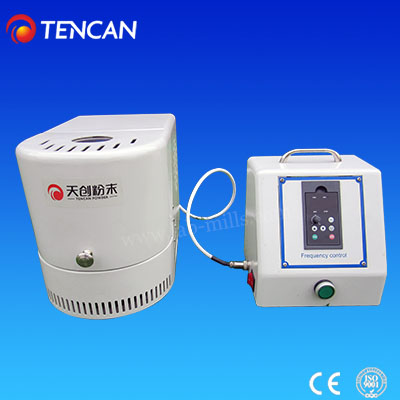Planetary ball mills are widely recognized for their ability to achieve exceptional grinding results.
However, within this category, horizontal planetary ball mills offer a distinct set of advantages that make them a compelling choice for specific applications.
 Distinct Design, Unique Benefits
The key difference between horizontal and traditional planetary ball mills lies in the orientation of the grinding vials. In a horizontal mill, the vials sit parallel to the ground, rotating along a horizontal axis. This seemingly minor difference unlocks several performance benefits:
Reduced Sedimentation: A common challenge with traditional mills is material settling at the bottom of the vial during the grinding process. This can lead to uneven particle size distribution and inefficiencies. The horizontal design mitigates this issue. Since the vials are positioned horizontally, the material constantly moves throughout the vial, minimizing sedimentation and promoting more uniform grinding.
Enhanced Mixing: The horizontal rotation in these mills creates a strong rolling and churning motion within the vials. This not only improves grinding efficiency but also excels at thoroughly mixing materials. This makes horizontal planetary ball mills ideal for applications where homogenous mixtures are desired, such as in composite material development or preparation of catalyst precursors.
Distinct Design, Unique Benefits
The key difference between horizontal and traditional planetary ball mills lies in the orientation of the grinding vials. In a horizontal mill, the vials sit parallel to the ground, rotating along a horizontal axis. This seemingly minor difference unlocks several performance benefits:
Reduced Sedimentation: A common challenge with traditional mills is material settling at the bottom of the vial during the grinding process. This can lead to uneven particle size distribution and inefficiencies. The horizontal design mitigates this issue. Since the vials are positioned horizontally, the material constantly moves throughout the vial, minimizing sedimentation and promoting more uniform grinding.
Enhanced Mixing: The horizontal rotation in these mills creates a strong rolling and churning motion within the vials. This not only improves grinding efficiency but also excels at thoroughly mixing materials. This makes horizontal planetary ball mills ideal for applications where homogenous mixtures are desired, such as in composite material development or preparation of catalyst precursors.
 Adaptability for Different Materials: The horizontal design can be particularly advantageous for processing viscous materials or materials with a tendency to cake. The rolling motion within the vials effectively overcomes these challenges, allowing for more efficient grinding.
Applications Tailored for Horizontal Performance
While horizontal planetary ball mills offer several advantages, they are particularly well-suited for specific applications:
Preparation of Battery Materials: These mills excel at mixing and grinding the various components that make up battery electrodes, ensuring a uniform and high-performing final product.
Processing of Viscous Materials: Materials like polymers, resins, and pastes can be effectively mixed and ground in horizontal mills due to their superior mixing capabilities.
Comminution of Biological Samples: The horizontal design minimizes sample heating during grinding, making it ideal for processing temperature-sensitive biological samples.
Beyond the Advantages
It's important to acknowledge that horizontal planetary ball mills may not be the perfect solution for every application. Here are some factors to consider when making your choice:
Sample Volume: Horizontal mills typically have a smaller vial capacity compared to traditional models. For large-scale processing needs, a traditional planetary ball mill might be more suitable.
Desired Particle Size: While horizontal mills achieve excellent results, they may not reach the absolute finest particle sizes achievable with some high-energy vertical models.
Conclusion
Horizontal planetary ball mills provide a unique and valuable option within the world of material processing. Their innovative design offers distinct advantages in terms of reduced sedimentation, enhanced mixing, and suitability for specific material types. By carefully considering your application requirements, horizontal planetary ball mills can become a powerful tool for achieving your desired grinding and mixing goals.
Adaptability for Different Materials: The horizontal design can be particularly advantageous for processing viscous materials or materials with a tendency to cake. The rolling motion within the vials effectively overcomes these challenges, allowing for more efficient grinding.
Applications Tailored for Horizontal Performance
While horizontal planetary ball mills offer several advantages, they are particularly well-suited for specific applications:
Preparation of Battery Materials: These mills excel at mixing and grinding the various components that make up battery electrodes, ensuring a uniform and high-performing final product.
Processing of Viscous Materials: Materials like polymers, resins, and pastes can be effectively mixed and ground in horizontal mills due to their superior mixing capabilities.
Comminution of Biological Samples: The horizontal design minimizes sample heating during grinding, making it ideal for processing temperature-sensitive biological samples.
Beyond the Advantages
It's important to acknowledge that horizontal planetary ball mills may not be the perfect solution for every application. Here are some factors to consider when making your choice:
Sample Volume: Horizontal mills typically have a smaller vial capacity compared to traditional models. For large-scale processing needs, a traditional planetary ball mill might be more suitable.
Desired Particle Size: While horizontal mills achieve excellent results, they may not reach the absolute finest particle sizes achievable with some high-energy vertical models.
Conclusion
Horizontal planetary ball mills provide a unique and valuable option within the world of material processing. Their innovative design offers distinct advantages in terms of reduced sedimentation, enhanced mixing, and suitability for specific material types. By carefully considering your application requirements, horizontal planetary ball mills can become a powerful tool for achieving your desired grinding and mixing goals.
